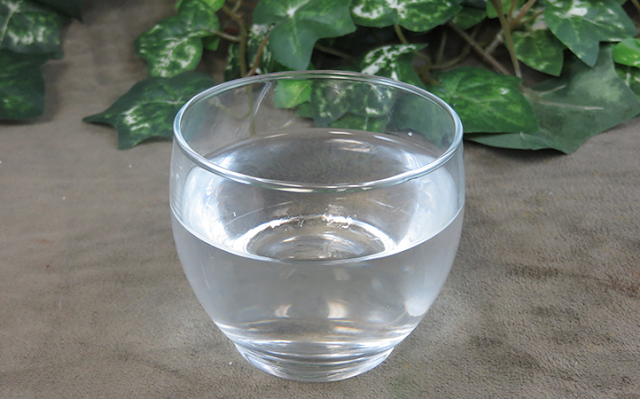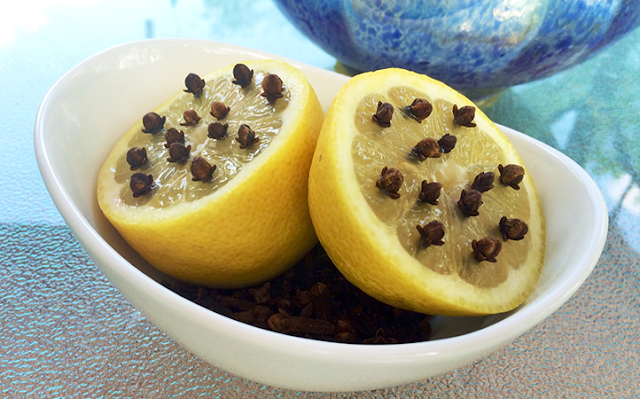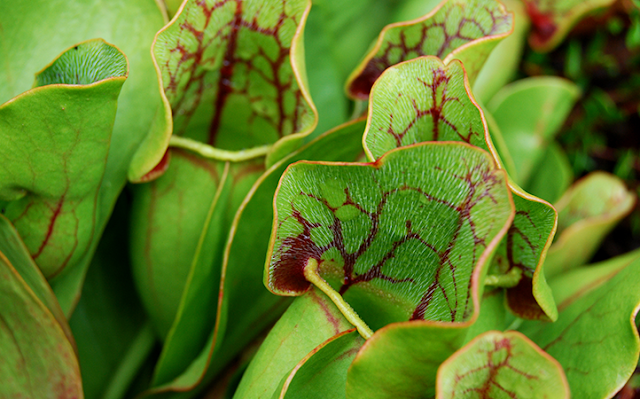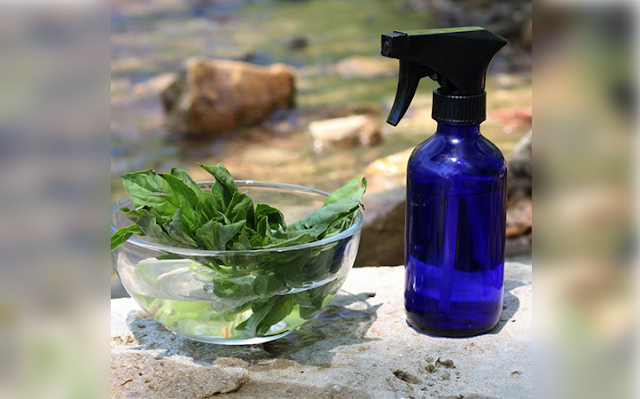INTRODUCTION
 Concrete which forms major component in the construction Industry as it is cheap, easily available and convenient to cast. But drawback of these materials is it is weak in tension so, it cracks under sustained loading and due to aggressive environmental agents which ultimately reduce the life of the structure which are built using these materials. This process of damage occurs in the early life of the building structure and also during its life time. Synthetic materials like epoxies are used for remediation. But, they are not compatible, costly, reduce aesthetic appearance and need constant maintenance. Therefore bacterial induced Calcium Carbonate (Calcite) precipitation has been proposed as an alternative and environment friendly crack remediation and hence improvement of strength of building materials. the concept was first introduced by Ramakrishna. Journal publication on self-healing concrete over the last A novel technique is adopted in re-mediating cracks and fissures in concrete by utilizing Microbiologically Induced Calcite or Calcium Carbonate (CaCO3) Precipitation (MICP) is a technique that comes under a broader category of science called bio- mineralization. MICP is highly desirable because the Calcite precipitation induced as a result of microbial activities is pollution free and natural. The technique can be used to improve the compressive strength and stiffness of cracked concrete specimens. Research leading to microbial Calcium Carbonate precipitation and its ability to heal cracks of construction materials has led to many applications like crack remediation of concrete, sand consolidation, applications.so it can be define as "The process can occur inside or outside the microbial cell or even some distance away within the concrete. Often bacterial activities simply trigger a change in solution chemistry that leads to over saturation and mineral precipitation. Use of these Bio mineralogy concepts in concrete leads to potential invention of new material called ―Bacterial Concrete"
Concrete which forms major component in the construction Industry as it is cheap, easily available and convenient to cast. But drawback of these materials is it is weak in tension so, it cracks under sustained loading and due to aggressive environmental agents which ultimately reduce the life of the structure which are built using these materials. This process of damage occurs in the early life of the building structure and also during its life time. Synthetic materials like epoxies are used for remediation. But, they are not compatible, costly, reduce aesthetic appearance and need constant maintenance. Therefore bacterial induced Calcium Carbonate (Calcite) precipitation has been proposed as an alternative and environment friendly crack remediation and hence improvement of strength of building materials. the concept was first introduced by Ramakrishna. Journal publication on self-healing concrete over the last A novel technique is adopted in re-mediating cracks and fissures in concrete by utilizing Microbiologically Induced Calcite or Calcium Carbonate (CaCO3) Precipitation (MICP) is a technique that comes under a broader category of science called bio- mineralization. MICP is highly desirable because the Calcite precipitation induced as a result of microbial activities is pollution free and natural. The technique can be used to improve the compressive strength and stiffness of cracked concrete specimens. Research leading to microbial Calcium Carbonate precipitation and its ability to heal cracks of construction materials has led to many applications like crack remediation of concrete, sand consolidation, applications.so it can be define as "The process can occur inside or outside the microbial cell or even some distance away within the concrete. Often bacterial activities simply trigger a change in solution chemistry that leads to over saturation and mineral precipitation. Use of these Bio mineralogy concepts in concrete leads to potential invention of new material called ―Bacterial Concrete"
BACTERIAL CONCRETE:
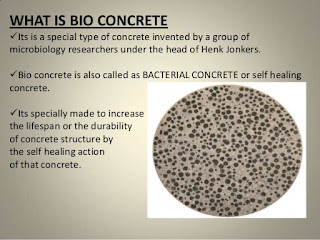 Cracks in concrete are inevitable and are one of the inherent weaknesses of concrete. Water and other salts seep through these cracks, corrosion initiates, and thus reduces the life of concrete. So there was a need to develop an inherent biomaterial, a self-repairing material which can remediate the cracks and fissures in concrete. Bacterial concrete is a material, which can successfully remediate cracks in concrete. This technique is highly desirable because the mineral precipitation induced as a result of microbial activities is pollution free and natural. As the cell wall of bacteria is anionic, metal accumulation (calcite) on the surface of the wall is substantial, thus the entire cell becomes crystalline and they eventually plug the pores and cracks in concrete. This paper discusses the plugging of artificially cracked cement mortar using Bacillus Pasteurii and Sporosarcina bacteria combined with sand as a filling material in artificially made cuts in cement mortar which was cured in urea and CaCl2 medium. The effect on the compressive strength and stiffness of the cement mortar cubes due to the mixing of bacteria is also discussed in this paper. It was found that use of bacteria improves the stiffness and compressive strength of concrete. Scanning electron microscope (SEM) is used to document the role of bacteria in microbiologically induced mineral precipitation. Rod like impressions were found on the face of calcite crystals indicating the presence of bacteria in those places. Energy- dispersive X-ray (EDX) spectra of the microbial precipitation on the surface of the crack indicated the abundance of calcium and the precipitation was inferred to be calcite (CaCO3)
Cracks in concrete are inevitable and are one of the inherent weaknesses of concrete. Water and other salts seep through these cracks, corrosion initiates, and thus reduces the life of concrete. So there was a need to develop an inherent biomaterial, a self-repairing material which can remediate the cracks and fissures in concrete. Bacterial concrete is a material, which can successfully remediate cracks in concrete. This technique is highly desirable because the mineral precipitation induced as a result of microbial activities is pollution free and natural. As the cell wall of bacteria is anionic, metal accumulation (calcite) on the surface of the wall is substantial, thus the entire cell becomes crystalline and they eventually plug the pores and cracks in concrete. This paper discusses the plugging of artificially cracked cement mortar using Bacillus Pasteurii and Sporosarcina bacteria combined with sand as a filling material in artificially made cuts in cement mortar which was cured in urea and CaCl2 medium. The effect on the compressive strength and stiffness of the cement mortar cubes due to the mixing of bacteria is also discussed in this paper. It was found that use of bacteria improves the stiffness and compressive strength of concrete. Scanning electron microscope (SEM) is used to document the role of bacteria in microbiologically induced mineral precipitation. Rod like impressions were found on the face of calcite crystals indicating the presence of bacteria in those places. Energy- dispersive X-ray (EDX) spectra of the microbial precipitation on the surface of the crack indicated the abundance of calcium and the precipitation was inferred to be calcite (CaCO3)
THE BIOLOGICAL SELF -HEALING PROCESS:
 It is important to cover what kinds of bacteria will live in the concrete, how they work to improve the longevity of public infrastructure, what the catalyst will be that causes the chemical reaction in the bacteria, what happens to the specific kinds of specialized bacteria when exposed to the catalyst, and how they work together to not only heal cracks before they form, but also strengthen the overall structure they are incorporated into. When the bacteria are exposed to the air and the "food," the bacteria go through a chemical process that causes them to harden and fuse, filling in the crack that has formed, strengthening the structure of the concrete, and adhering to the sides of the crack to seal the damage site. This process extends the lifespan of the structure while also fixing the damage caused. The process of healing a crack can take as little as a few days [3] . When we look at the crack sizes, we generally are looking in then micro- to nano meter range to maximize the healing potential. Concrete constructions are currently designed according to set norms that allow cracks to form up to 0.2 mm wide [4][5]. Such micro cracks are generally considered acceptable, as these do not directly impair the safety and strength of a construction. Moreover, micro cracks sometimes heal themselves as many types of concrete feature a certain crack-healing capacity. Research has shown that this so called 'autonomous' healing capacity is largely related to the number of non-reacted cement particles present in the concrete matrix. On crack formation, ingress water reacts with these particles, resulting in closure of micro cracks. However, because of the variability of autonomous crack healing of concrete constructions, water leakage as a result of micro crack formation in tunnel and underground structures can occur. While self-healing of 0.2 mm wide cracks occurred in 30% of the control samples, complete closure of all cracks was obtained in all bacteria- based samples. Moreover, the crack sealing capacity of the latter group was found to be extended to 0.5 mm cracks.The basic concept behind our specific version of self-healing concrete is utilizing certain types of bacteria (in the present case bacillus subtilus) and how they function to seal microscopic cracks in the concrete before they grow into larger and harder to manage cracks and breaks. This bio calcification process involves several elements, working in unison, to complete these tasks. During the process the enzymatic hydrolysis of urea takes place forming ammonia and carbon dioxide. Urease which is provided by bacteria deposits CaCo3, a highly impermeable calcite layer, over the surface of an already existing concrete layer which is relatively dense and can block cracks and thus hamper ingress of water efficiently increasing corrosion resistance and consequently increasing the strength and durability of concrete structures[8]. MICP is a complex mechanism and is a function of cell concentration, ionic strength, nutrient and pH of the medium. Modern techniques such as X-ray diffraction tests, TEM & SEM analysis can be used to quantify the study of stages of calcite deposition on the surface and in cracks
It is important to cover what kinds of bacteria will live in the concrete, how they work to improve the longevity of public infrastructure, what the catalyst will be that causes the chemical reaction in the bacteria, what happens to the specific kinds of specialized bacteria when exposed to the catalyst, and how they work together to not only heal cracks before they form, but also strengthen the overall structure they are incorporated into. When the bacteria are exposed to the air and the "food," the bacteria go through a chemical process that causes them to harden and fuse, filling in the crack that has formed, strengthening the structure of the concrete, and adhering to the sides of the crack to seal the damage site. This process extends the lifespan of the structure while also fixing the damage caused. The process of healing a crack can take as little as a few days [3] . When we look at the crack sizes, we generally are looking in then micro- to nano meter range to maximize the healing potential. Concrete constructions are currently designed according to set norms that allow cracks to form up to 0.2 mm wide [4][5]. Such micro cracks are generally considered acceptable, as these do not directly impair the safety and strength of a construction. Moreover, micro cracks sometimes heal themselves as many types of concrete feature a certain crack-healing capacity. Research has shown that this so called 'autonomous' healing capacity is largely related to the number of non-reacted cement particles present in the concrete matrix. On crack formation, ingress water reacts with these particles, resulting in closure of micro cracks. However, because of the variability of autonomous crack healing of concrete constructions, water leakage as a result of micro crack formation in tunnel and underground structures can occur. While self-healing of 0.2 mm wide cracks occurred in 30% of the control samples, complete closure of all cracks was obtained in all bacteria- based samples. Moreover, the crack sealing capacity of the latter group was found to be extended to 0.5 mm cracks.The basic concept behind our specific version of self-healing concrete is utilizing certain types of bacteria (in the present case bacillus subtilus) and how they function to seal microscopic cracks in the concrete before they grow into larger and harder to manage cracks and breaks. This bio calcification process involves several elements, working in unison, to complete these tasks. During the process the enzymatic hydrolysis of urea takes place forming ammonia and carbon dioxide. Urease which is provided by bacteria deposits CaCo3, a highly impermeable calcite layer, over the surface of an already existing concrete layer which is relatively dense and can block cracks and thus hamper ingress of water efficiently increasing corrosion resistance and consequently increasing the strength and durability of concrete structures[8]. MICP is a complex mechanism and is a function of cell concentration, ionic strength, nutrient and pH of the medium. Modern techniques such as X-ray diffraction tests, TEM & SEM analysis can be used to quantify the study of stages of calcite deposition on the surface and in cracks
VIABLE BACTERIA AS SELF HEALING AGENT:
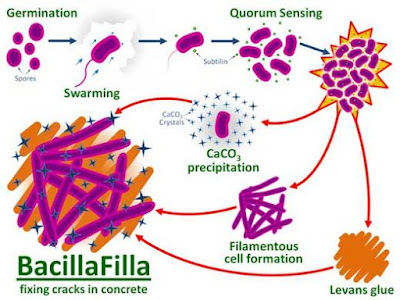 The bacteria to be used as self-healing agent in concrete should be fit for the job, i.e. they should be able to perform long-term effective crack sealing, preferably during the total constructions life time. The principle mechanism of bacterial crack healing is that the bacteria themselves act largely as a catalyst, and transform a precursor compound to a suitable filler material. The newly produced compounds such as calcium carbonate-based mineral precipitates should than act as a type of bio-cement what effectively seals newly formed cracks. Thus for effective self-healing, both bacteria and a bio-cement precursor compound should be integrated in the material matrix. However, the presence of the matrix- embedded bacteria and precursor compounds should not negatively affect other wanted concrete characteristics. Bacteria that can resist concrete matrix incorporation exist in nature, and these appear related to a specialized group of alkali-resistant spore-forming bacteria. Interesting feature of these bacteria is that they are able to form spores, which are specialized spherical thick-walled cells somewhat homologous to plant seeds. These spores are viable but dormant cells and can withstand mechanical and chemical stresses and remain in dry state viable for periods over 50 years However, when bacterial spores were directly added to the concrete mixture, their life- time appeared to be limited to one-two months [16]. The decrease in life- time of the bacterial spores from several decades when in dry state to only a few months when embedded in the concrete matrix may be due to continuing cement hydration resulting in matrix pore-diameter widths typically much smaller than the 1-µm sized bacterial spores [16]. Another concern is whether direct addition of organic bio-mineral precursor compounds to the concrete mixture will not result in unwanted loss of other concrete properties. In the preceding study it was indeed found that various organic bio-cement precursor compounds such as yeast extract, peptone and calcium acetate resulted in a dramatic decrease of compressive strength. The only exception appeared to be calcium lactate what actually resulted in a 10% increase in compressive strength compared to control specimens In order to substantially increase the lifetime and associated functionality of concrete incorporated bacteria, the effect of bacterial spore and simultaneously needed organic bio- mineral precursor compound (calcium lactate) immobilization in porous expanded clay particles was tested in this study. It was found that protection of the bacterial spores by immobilization inside porous expanded clay particles before addition to the concrete mixture indeed substantially prolonged their life-time. Currently running viability experiments show that still after 6 months concrete incorporation no loss of viability is observed, suggesting that their long term viability as observed in dried state when not embedded in concrete is maintained
The bacteria to be used as self-healing agent in concrete should be fit for the job, i.e. they should be able to perform long-term effective crack sealing, preferably during the total constructions life time. The principle mechanism of bacterial crack healing is that the bacteria themselves act largely as a catalyst, and transform a precursor compound to a suitable filler material. The newly produced compounds such as calcium carbonate-based mineral precipitates should than act as a type of bio-cement what effectively seals newly formed cracks. Thus for effective self-healing, both bacteria and a bio-cement precursor compound should be integrated in the material matrix. However, the presence of the matrix- embedded bacteria and precursor compounds should not negatively affect other wanted concrete characteristics. Bacteria that can resist concrete matrix incorporation exist in nature, and these appear related to a specialized group of alkali-resistant spore-forming bacteria. Interesting feature of these bacteria is that they are able to form spores, which are specialized spherical thick-walled cells somewhat homologous to plant seeds. These spores are viable but dormant cells and can withstand mechanical and chemical stresses and remain in dry state viable for periods over 50 years However, when bacterial spores were directly added to the concrete mixture, their life- time appeared to be limited to one-two months [16]. The decrease in life- time of the bacterial spores from several decades when in dry state to only a few months when embedded in the concrete matrix may be due to continuing cement hydration resulting in matrix pore-diameter widths typically much smaller than the 1-µm sized bacterial spores [16]. Another concern is whether direct addition of organic bio-mineral precursor compounds to the concrete mixture will not result in unwanted loss of other concrete properties. In the preceding study it was indeed found that various organic bio-cement precursor compounds such as yeast extract, peptone and calcium acetate resulted in a dramatic decrease of compressive strength. The only exception appeared to be calcium lactate what actually resulted in a 10% increase in compressive strength compared to control specimens In order to substantially increase the lifetime and associated functionality of concrete incorporated bacteria, the effect of bacterial spore and simultaneously needed organic bio- mineral precursor compound (calcium lactate) immobilization in porous expanded clay particles was tested in this study. It was found that protection of the bacterial spores by immobilization inside porous expanded clay particles before addition to the concrete mixture indeed substantially prolonged their life-time. Currently running viability experiments show that still after 6 months concrete incorporation no loss of viability is observed, suggesting that their long term viability as observed in dried state when not embedded in concrete is maintained
HOW DOES BACTERIA REMIDIATE CRACKS:
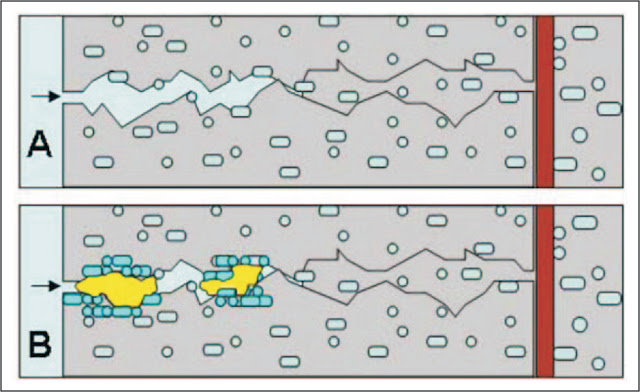
When the concrete is mixed with bacteria (bacillus subtilus), the bacteria go into a dormant state, a lot like seeds. All the bacteria need is exposure to the air to activate their functions. Any cracks that should occur provide the necessary exposure. When the cracks form, bacteria very close proximity to the crack, starts precipitating calcite crystals. When a concrete structure is damaged and water starts to seep through the cracks that appear in the concrete, the spores of the bacteria germinate on contact with the water and nutrients. Having been activated, the bacteria start to feed on the calcium lactate nutrient. Such spores have extremely thick cell walls that enable them to remain intact for up to 200 years while waiting for a better environment to germinate. As the bacteria feeds oxygen is consumed and the soluble calcium lactate is converted to insoluble limestone. The limestone solidifies on the cracked surface, thereby sealing it up. Oxygen is an essential element in the process of corrosion of steel and when the bacterial activity has consumed it all it increases the durability of steel reinforced concrete constructions. Tests all show that bacteria embedded concrete has lower water and chloride permeability and higher strength regain than the surface application of bacteria. The last, but certainly not least, key component of the self-healing concrete formula is the bacteria themselves. The most promising bacteria to use for self- healing purposes are alkaliphilic (alkali- resistant) spore-forming bacteria. The bacteria, from the genus Bacillus, subtilus is adopted for present study. It is of great concern to the construction industry whether or not these bacteria are "smart" enough to know when their task is complete because of safety concerns. Bacillus Subtilus which is a soil bacterium (isolated from JNTUH soil) is harmless to humans as it is non-pathogenic microorganism.
Chemistry of the Process Microorganisms (cell surface charge is negative) draw cations including Ca2+ from the environment to deposit on the cell surface. The following equations summarize the role of
bacterial cell as a nucleation site 14
Ca 2+ + Cell --------> Cell- Ca 2+
Cell- Ca 2+ +CO 32-----> Cell-CaCO 3
The bacteria can thus act as a nucleation site which facilitates in the precipitation of calcite which can eventually plug the pores and cracks in the concrete. This microbiologically induced calcium carbonate precipitation (MICCP) comprises of a series of complex biochemical reactions. As part of metabolism, B.Subtilus produces urease, which catalyses urea to produce CO 2 and ammonia, resulting in an increase of pH in the surroundings where ions Ca 2+ and CO 32- precipitate as CaCO 3 . These create calcium carbonate crystals that further expand and grow as the bacteria devour the calcium lactate food. The crystals expand until the entire gap is filled. In any place where standard concrete is currently being used, there is potential for the use of bacterial self- healing concrete instead. The advantage of having self- healing properties is that the perpetual and expected cracking that occurs in every concrete structure due to its brittle nature can be controlled, reduced, and repaired without a human work crew. Bacterial self-healing concrete also prevents the exposure of the internal reinforcements. This form of self-healing concrete was created to continuously heal any damage done on or in the concrete structure. It was made to extend the life span of a concrete structure of any size, shape, or project and to add extra protection to the steel reinforcements from the elements. With this process, money can be saved, structures will last far longer, and the concrete industry as a whole will be turning out a far more sustainable product, effectively reducing its CO2 contribution.
RESULTS AND DISCUSSION
These results have been taken from the irjet journal paper. The results were taken from the experiment conducted and tested for 7 ,14 and 28 days:
1. Bacillus subtilis can be produced from lab which is proved to be a safe and cost effective.
2. The addition of bacillus subtilis bacteria improves the hydrated structure of cement mortar.
3. The compressive strength of cement mortar is maximum with the addition of bacillus subtilis bacteria for a cell concentration of 105 cells per ml of mixing water. So, bacteria with a cell concentration of 105 cells per ml of mixing water was used in the investigation.
4. The addition of bacillus subtilis bacteria increases the compressive strength of concrete. In standard grade concrete the compressive strength is increased upto14.92% at 28 days by addition of bacillus subtilis bacteria when compared to conventional concrete. The addition of bacillus subtilis bacteria showed significant improvement in the split tensile strength than the conventional concrete.
CONCLUSION:
 Use of bacteria as self-healing agents helps in healing the cracks that are caused in the structure due to many reasons. The calcite material secreted by bacteria when exposed to the environment fills the cracks developed. With this not only cracks are healed but life of concrete is also enhanced. The action of bacteria is automatic so there is no need of tension as cracks are healed itself.
Use of bacteria as self-healing agents helps in healing the cracks that are caused in the structure due to many reasons. The calcite material secreted by bacteria when exposed to the environment fills the cracks developed. With this not only cracks are healed but life of concrete is also enhanced. The action of bacteria is automatic so there is no need of tension as cracks are healed itself.
The overall conclusion of this work is that the proposed two component bio-chemical healing agent, composed of bacterial spores and a suitable organic bio-cement precursor compound, using porous expanded clay particles as a reservoir is a promising bio-based and thus sustainable alternative to strictly chemical or cement-based healing agents, particularly in situations where concrete parts of a construction are not accessible for manual inspection or repair. However, before practical application becomes feasible, further optimization of the proposed system is needed. E.g., the amount of healing agent needed should be minimized in order to become economically competitive with currently existing repair techniques and furthermore to reduce consequences such as loss in compressive strength.
REFERENCES:
1. Ramakrishnan V, Ramesh KP, and Bang SS. South Dokata School of Mines and Technology, USA, Bacterial Concrete, Proceedings of SPIE, Vol. 4234 pp. 168-176,Smart Materials.
2. Ramchandran SK, Ramakrishnan V, and Bang SS. South Dokata School of Mines and Technology, USA Remediation of concrete using Microorganisms ACI MaterialsJournal, 98(2001) 3-9.
3. Bouzoubaa N, Zhang MH, Malhotra VM. Mechanical properties and durability of concrete made with HVFA blended cements using a coarse FA. Cement and Concrete Research. 31(2001) 1393-1402.
4. Chiara Barabesi, Alessandro Galizzi, Giorgio Mastromei, Mila Rossi, Elena,Tamburini and Brunella Perito Pavia, Italy Bacillus subtilis Gene Cluster Involved inCalcium Carbonate
Biomineralization, Journal of Bacteriology, 2007, pp. 228-235.
ABSTRACT
Cracks in concrete are inevitable and are one of the inherent weaknesses of concrete. Water and other salts seep through these cracks, corrosion initiates, and thus reduces the life of concrete. So there was a need to develop an inherent biomaterial, a self-repairing material which can remediate the cracks and fissures in concrete. Bacterial concrete is a material, which can successfully remediate cracks in concrete. This technique is highly desirable because the mineral precipitation induced as a result of microbial activities is pollution free and natural. As the cell wall of bacteria is anionic, metal accumulation (calcite) on the surface of the wall is substantial, thus the entire cell becomes crystalline and they eventually plug the pores and cracks in concrete. This paper discusses the plugging of artificially cracked cement mortar using Bacillus Pasteurii and Sporosarcina bacteria combined with sand as a filling material in artificially made cuts in cement mortar which was cured in urea and CaCl2 medium. The effect on the compressive strength and stiffness of the cement mortar cubes due to the mixing of bacteria is also discussed in this paper. It was found that use of bacteria improves the stiffness and compressive strength of concrete. Scanning electron microscope (SEM) is used to document the role of bacteria in microbiologically induced mineral precipitation. Rod like impressions were found on the face of calcite crystals indicating the presence of bacteria in those places. Energy- dispersive X-ray (EDX) spectra of the microbial precipitation on the surface of the crack indicated the abundance of calcium and the precipitation was inferred to be calcite (CaCO3)
INTRODUCTION
Concrete which forms major component in the construction Industry as it is cheap, easily available and convenient to cast. But drawback of these materials is it is weak in tension so, it cracks under sustained loading and due to aggressive environmental agents which ultimately reduce the life of the structure which are built using these materials. This process of damage occurs in the early life of the building structure and also during its life time. Synthetic materials like epoxies are used for remediation. But, they are not compatible, costly, reduce aesthetic appearance and need constant maintenance. Therefore bacterial induced Calcium Carbonate (Calcite) precipitation has been proposed as an alternative and environment friendly crack remediation and hence improvement of strength of building materials. the concept was first introduced by Ramakrishna. Journal publication on self-healing concrete over the last A novel technique is adopted in re-mediating cracks and fissures in concrete by utilizing Microbiologically Induced Calcite or Calcium Carbonate (CaCO3) Precipitation (MICP) is a technique that comes under a broader category of science called bio- mineralization. MICP is highly desirable because the Calcite precipitation induced as a result of microbial activities is pollution free and natural. The technique can be used to improve the compressive strength and stiffness of cracked concrete specimens. Research leading to microbial Calcium Carbonate precipitation and its ability to heal cracks of construction materials has led to many applications like crack remediation of concrete, sand consolidation, applications.so it can be define as "The process can occur inside or outside the microbial cell or even some distance away within the concrete. Often bacterial activities simply trigger a change in solution chemistry that leads to over saturation and mineral precipitation. Use of these Bio mineralogy concepts in concrete leads to potential invention of new material called ―Bacterial Concrete"
CONCRETE:
Concrete is a composite material composed of coarse granular material (the aggregate or filler) embedded in a hard matrix of material (the cement or binder) that fills the space between the aggregate particles and glues them together. We can also consider concrete as a composite material that consists essentially of a binding medium within which are embedded particles or fragments of aggregates. The simplest representation of concrete is:
Concrete = Filler + Binder.
According to the type of binder used, there are many different kinds of concrete. For instance, Portland cement concrete, asphalt concrete, and epoxy concrete. In concrete construction, the Portland cement concrete is utilized the most. Thus, in our course, the term concrete usually refers to Portland cement concrete. For this kind of concrete, the composition can be presented as follows
Cement +
(+ Admixture) → Cement paste
+ Water + → mortar
Fine aggregate + →concrete
Coarse aggregate
Here we should indicate that admixtures are almost always used in modern practice and thus become an essential component of modern concrete. Admixtures are defined as materials other than aggregate (fine and coarse), water, fibre and cement, which are added into c o n c r e t e b a t c h i m m e d i a t e l y b e f o r e or d u r i n g m i x i n g . The w i d e s p r e a d use of admixture is mainly due to the many benefits made possible by their application. For instance, chemical admixtures can modify the setting and hardening characteristic of cement paste by influencing the rate of cement hydration. Water-reducing admixture can plasticize fresh concrete mixtures by reducing surface tension of water, air-entraining admixtures can improve the durability of concrete, and mineral admixtures such as pozzolanas (materials containing reactive silica) can reduce thermal cracking.
Advantages:
a) Economical: Concrete is the most inexpensive and the most readily available material. The cost of production of concrete is low compared with other engineered construction materials. Three major components: water, aggregate and cement. Comparing with steel, plastic and polymer, they are the most inexpensive materials and available in every corner of the world. This enables concrete to be locally produced anywhere in the world, thus avoiding the transportation costs necessary for most other materials.
b). ambient temperature hardened material: Because cement is a low temperature bonded inorganic material and its reaction occurs at room temperature, concrete can gain its strength at ambient temperature.
c) Ability to be cast: It can be formed into different desired shape and sizes right at the construction site.
d) Energy efficiency: Low energy consumption for production, compare with steel especially. The energy content of plain concrete is 450-750 kWh / ton and that of reinforced concrete is 800-3200 kWh/ton, compared with 8000 kWh/ton for structural steel
e) Excellent resistance to water. Unlike wood and steel, concrete can harden in water and can withstand the action of water without serious deterioration. This makes concrete an ideal material for building structures to control, store, and transport water. Examples include pipelines (such as the Central Arizona Project, which provide water from Colorado River to central Arizona. The system contains1560 pipe sections, each 6.7 m long and 7.5 m in outside diameter 6.4 m inside diameter), dams, and submarine structures. Contrary to popular belief, pure water is not deleterious to concrete, even to reinforced concrete: it is the chemicals dissolved in water, such as chlorides, sulphates, and carbon dioxide, which cause deterioration of concrete structures.
f). High temperature resistance: Concrete conducts heat slowly and is able to store considerable quantities of heat from the environment (can stand 6-8 hours in fire) and thus can be used as protective coating for steel structure.
g). Ability to consume waste: Many industrial wastes can be recycled as a substitute for cement or aggregate. Examples are fly ash, ground tire and slag.
h). Ability to work with reinforcing steel: Concrete and steel possess similar coefficient of thermal expansion (steel 1.2 x 10-5; concrete 1.0-1.5 x 10-5). Concrete also provides good protection to steel due to existing of CH (this is for normal condition). Therefore, while steel bars provide the necessary tensile strength, concrete provides a perfect environment for the steel, acting as a physical barrier to the ingress of aggressive species and preventing steel corrosion by providing a highly alkaline environment with pH about 13.5 to passivate the steel.
i) Less maintenance required: No coating or painting is needed as for steel structures.
Limitations:
a) Quasi-brittle failure mode: Concrete is a type of quasi-brittle material. (Solution: Reinforced concrete)
b) Low tensile strength: About 1/10 of its compressive strength. (Improvements: Fibre reinforced concrete; polymer concrete)
c) Low t o u g h n e s s : The ab i l i t y to ab s o rb en erg y is l o w. (Improvements: Faber reinforced concrete)
d) Low s t r e n g t h /BSG r a t i o ( specific s t r e n g t h ): Steel ( 300- 600)/7.8. Normal concrete (35-60)/2.3. Limited to middle-rise buildings. (Improvements: Lightweight concrete; high strength concrete)
e) Formwork is n e e d e d : Formwork f a b r i c a t i o n is l a b o u r i n t e n s i v e a n d t i m e consuming, hence costly (Improvement: Precast concrete)
f). long curing time: Full strength development needs a month. (Improvements: Steam curing)
g). working with cracks: Most reinforced concrete structures have cracks under service load. (Improvements: Pressurised concrete).
DURABILITY:
Almost universally, concrete has been specified principally on the basis of its compressive strength at 28 days after casting. Since reinforced concrete structures are usually designed with a sufficiently high safety factor, it is rare for concrete structures to fail due to lack of intrinsic strength. However, gradual deterioration caused by the lack of durability reduces the safety margin of concrete structures to an extent that serious concerns have been raised. The extent of the problem is such that concrete durability has been recently described as a "multimillion dollar opportunity". In the U. S. A., the cost of repairing the interstate highway bridges alone is 20 Billion U.S. dollars. In developed countries, it is estimated that over 40% of the total resources of the building industry are applied to repair and maintenance of existing structures. In Hong Kong, steel corrosion and chemical attack on concrete have created a lot of problems. Some new pipelines can not even last for five years. Steel corrosion has led to the collapse of canopies, resulting in death and injury of people. Durability of concrete can be defined as its ability to resist weathering action, chemical attack, abrasion, or any other process of deterioration, and hence to retain its original shape, dimension, quality and serviceability.
Causes of deterioration and main durability problems:
Physical causes:
1. Surface wear ( abrasion, erosion and cavitation)
2. Cracking (Volume c h a n g e s , l o a d i n g d a m a g e , a n d e x t r e m e temperature damage)
Chemical causes:
1. Alkali-aggregate reaction
2. Sulphate attack
3. Steel corrosion
The most severe durability problems always involve the penetration of water (with corrosive agents) into the concrete. Physical action (e.g., water freezing) or chemical reaction (e.g., alkali-aggregate reaction) will then lead to internal expansion, resulting in significant cracking/spalling of the concrete. Durability of concrete is hence related to the ease of ingress of water and chemicals. Concrete permeability and diffusivity are hence important parameters to be considered. Among the main reason for reducing the durability of concrete cracks in concrete is one.
CRACKS IN CONCRETE:
Cracks in concrete are extremely common but often misunderstood. When an owner sees a crack in his slab or wall, especially if the concrete is relatively new, he automatically assumes there's something wrong. This is not always the case. Some types of cracks are inevitable. The best that a contractor can do is to try to control the cracking. This is done by properly preparing the subgrade, assuring that the concrete is not too wet, utilizing reinforcement where needed, and by properly placing and spacing crack control joints and expansion joints. However, sometimes cracks happen in spite of any precautions taken.
TYPES OF CRACKS:
1. Shrinkage cracking: A crack that occurs only in unhardened concrete. It is often seen as relatively straight lines running parallel with the span of the floor.
2. Plastic cracking: A type of shrinkage crack that also only occurs in unhardened concrete. It is seen as diagonal lines in the top of a slab. It is often caused by rapid drying of the surface due to delays in applying the curing membrane.
3. Settlement cracking: Caused by local restraining of unhardened concrete around reinforcement or some other obstruction.
4. Structural cracking: Usually a result of corrosion of the reinforcing steel or structural over stressing.
5. Tension cracking: Only occurs in reinforced concrete and is caused by elongation of the reinforcement in tension zones. It is sometimes seen around columns in flat slabs and on beam soffits near the middle of a span.
6. Rust cracking: The most common and most serious cause of structural cracking caused by inadequate reinforcement cover. It gradually develops at varying rates over time depending upon the degree of protection offered by the concrete cover.
7. Thermally-induced cracking: Results from stresses produced by temperature changes.
CAUSES OF CRACKS:
1. Plastic Shrinkage Cracking:
It occurs within 1 to 8 hours after placing, when subjected to a very rapid loss of moisture caused by a combination of factors, which include air and concrete temperatures, relative humidity and wind velocity at the surface of the concrete. These factors can combine to cause high rates of surface evaporation in either hot or cold weather
2. Plastic Settlement Cracking:
After initial placement, vibration and finishing concrete has tendency to continue to consolidate. During this period, the plastic concrete may be locally restrained by reinforcing steel, earlier placed hardened concrete or formwork. This local restraint may result in voids under the obstruction and cracks above the obstruction.
3. Drying Shrinkage Crack:
When associated with reinforcing steel, settlement cracking increases with increasing bar size, increasing slump and decreasing cover. The degree of settlement may increase with insufficient vibration, lack of compaction at top layers of concrete, or by the use of leaking or highly flexible forms. This is more of a problem with high bleed concrete particularly in winter when the cooler temperatures provide longer time to initial set and therefore a higher amount of bleed
4. Long Term Shrinkage Cracking:
Shrinkage is the inherent property of cement paste, which in pure form may shrink up to 1%. Aggregate provides internal restraint that reduces the magnitude of this volume change to about 0.06 percent. Shrinkage also occurs partly due to hydration of cement. On wetting concrete tends to expand but to a lower extent as compared to original shrinkage. Concrete would continue to shrink during its lifetime albeit at a very reduced rate.
If the shrinkage of concrete could take place without restraint, the concrete would not crack. The combination of shrinkage and restraint cause tensile stresses to develop in the concrete, leading to cracking. In thicker section of concrete, tensile stresses are caused by differential shrinkage between the surface and the interior concrete. The larger shrinkage at the surface causes cracks to develop that may, with time, penetrate deeper into the concrete.
5. Concrete Crazing:
Crazing is the development of a network of fine random cracks or fissures on the surface of concrete caused by shrinkage of the surface layer. These cracks are rarely more than 3mm deep, and are more noticeable on over floated or steel-troweled surfaces. The irregular hexagonal areas enclosed by the cracks are typically no more than 40mm wide and may be as small as 10mm in unusual instances. Generally, craze cracks develop at an early age and are apparent the day after placement or at least by the end of the first weak. Often they are not readily visible until the surface has been wetted and it is beginning to dry. They do not affect the structural integrity of concrete and rarely do they affect durability. However crazed surfaces can be unsightly.
6. Thermal Cracking:
Temperature difference within a concrete structure may be caused by portions of the structure losing heat of hydration at different rates or by the weather conditions cooling or heating one portion of the structure to a different degree or at a different rate than another portion of the structure. These temperature differences result in differential volume change, leading to cracks. This is normally associated with mass concrete including large and thicker sections ( 500mm) of column, piers, beams, footings and slabs. Temperature differential due to changes in the ambient temperature can affect any structure.
7. Cracking due to Chemical Reaction:
Deleterious chemical reactions may cause cracking of concrete. These reactions may be due to materials used to make the concrete or materials that come into contact with the concrete after it has hardened. Concrete may crack with time as the result of slowly developing expansive reactions between aggregate containing active silica and alkalis derived from cement hydration, admixtures or external sources (e.g. curing water, ground water, alkaline solutions stored or used in the finished structure).The alkali silica reaction results in the formation of a swelling gel, which tends to draw water from other portions of the concrete. These causes local expansion and accompanying tensile stresses and may eventually result in the complete deterioration of the structure
8. Steel Corrosion induced Cracking:
Corrosion of the steel produces iron oxides and hydroxides, which have a volume much greater than the volume of the original metallic iron. This increase in volume causes high radial bursting stresses around reinforcing bars and results in local radial cracks. These splitting cracks can propagate along the bar, resulting in the formation of longitudinal cracks or spalling of the concrete. A broad crack may also form at a plane of bars parallel to a concrete surface resulting in delamination, a well-known problem in bridge decks. Cracks provide easy access for oxygen, moisture and chlorides and then minor splitting cracks can create a condition in which corrosion and cracking are accelerated.
9. Errors in Design and Detailing:
Errors that may result in unacceptable cracking include:
Poorly detailed re-entrant corners in walls, precast members and slabs. Improper selection and / or detailing of reinforcement.
Restraint to members subjects to volume changes caused by variations in temperature and moisture.
Lack of adequate contraction joints.
Improper design of foundations resulting in differential movement within the structure.
10. Improper Construction Joint:
Construction joints (C/J) are the weak planes vulnerable for development of cracks unless it is properly prepared




















